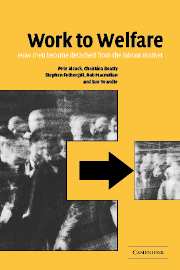Book contents
- Frontmatter
- Contents
- List of figures
- List of tables
- Notes on the authors
- Preface
- List of abbreviations
- Part I The context for labour market detachment
- Part II New evidence from the UK
- 4 The detached male workforce
- 5 Incapacity Benefit and unemployment
- 6 The over 50s
- 7 Family, life course and labour market detachment
- 8 The role of health in labour market detachment
- 9 Getting by
- 10 Back to work?
- Part III The policy implications
- Appendix: Research methodology
- References
- Index
4 - The detached male workforce
Published online by Cambridge University Press: 22 September 2009
- Frontmatter
- Contents
- List of figures
- List of tables
- Notes on the authors
- Preface
- List of abbreviations
- Part I The context for labour market detachment
- Part II New evidence from the UK
- 4 The detached male workforce
- 5 Incapacity Benefit and unemployment
- 6 The over 50s
- 7 Family, life course and labour market detachment
- 8 The role of health in labour market detachment
- 9 Getting by
- 10 Back to work?
- Part III The policy implications
- Appendix: Research methodology
- References
- Index
Summary
So just who are the men who have fallen out of the world of work? What are their skills, qualifications and work experience? How did they become detached from employment? Do they still want to work? And how do they get by, in terms of income and social security benefits? This chapter tries to provide answers to these basic questions, drawing mainly on a large-scale survey carried out in seven locations around Britain.
Chapter 1 outlined in broad terms the changing nature of men's experience of work, including the decline of traditional sources of male employment and the resulting issues of unemployment and economic inactivity. Before presenting the survey findings it is useful to look a little more closely specifically at the main statistical trends in non-employment among men across the country as a whole.
Trends in detachment
Figure 4.1 shows the trends in unemployment and economic inactivity among men of working age (i.e. 16–64) across Britain. The figures cover the years from 1977 to 2000. Unemployment – in this case the ILO measure from the Labour Force Survey – has fluctuated with the trade cycle. It rose steeply during the early 1980s, fell during the Lawson boom of the late 1980s, and rose again during the early 1990s. It subsequently fell once more to levels not much above those in the 1970s. In spring 2000 the Labour Force Survey recorded 950,000 men as unemployed in Great Britain, or 5.1 per cent of the male WAP.
- Type
- Chapter
- Information
- Work to WelfareHow Men Become Detached from the Labour Market, pp. 79 - 110Publisher: Cambridge University PressPrint publication year: 2003
- 3
- Cited by

